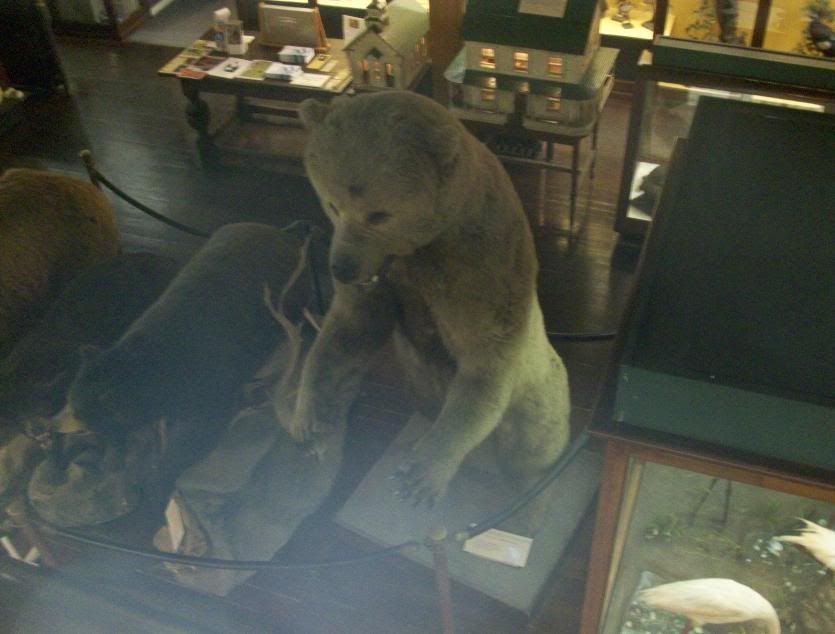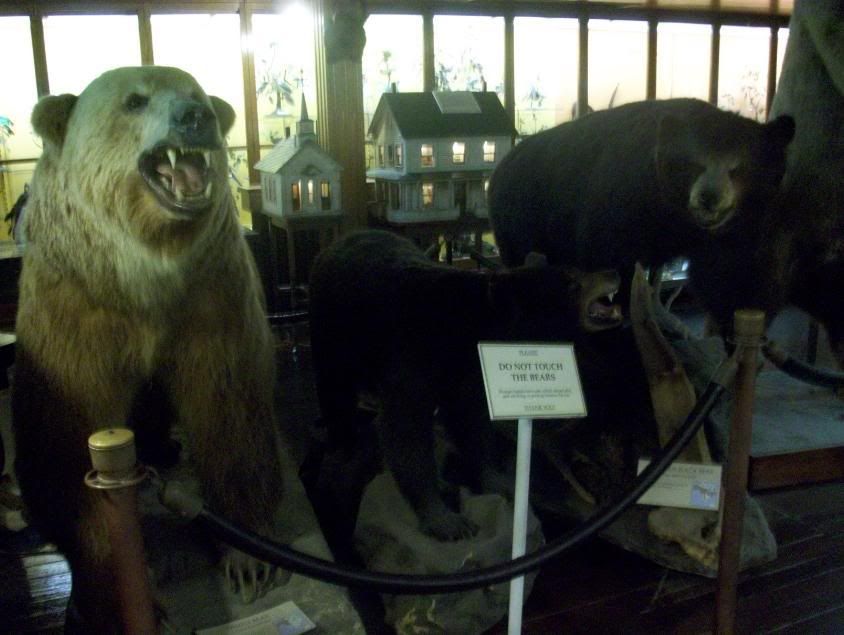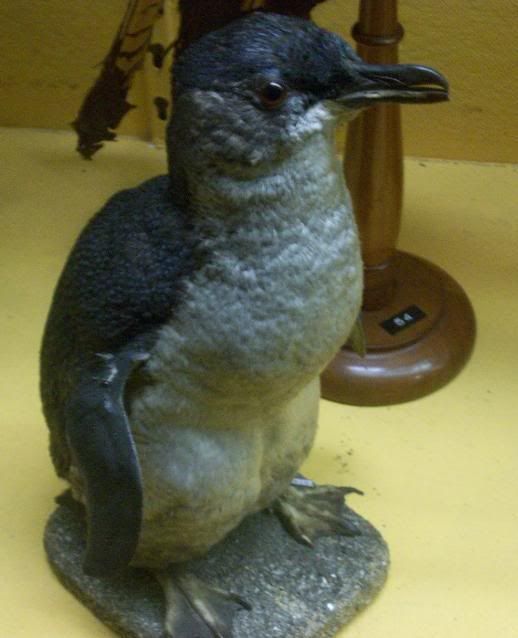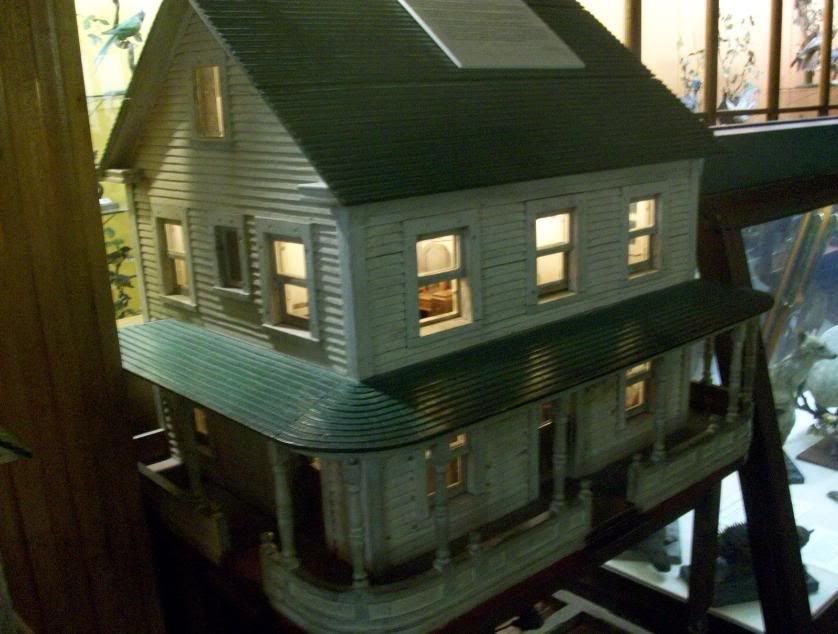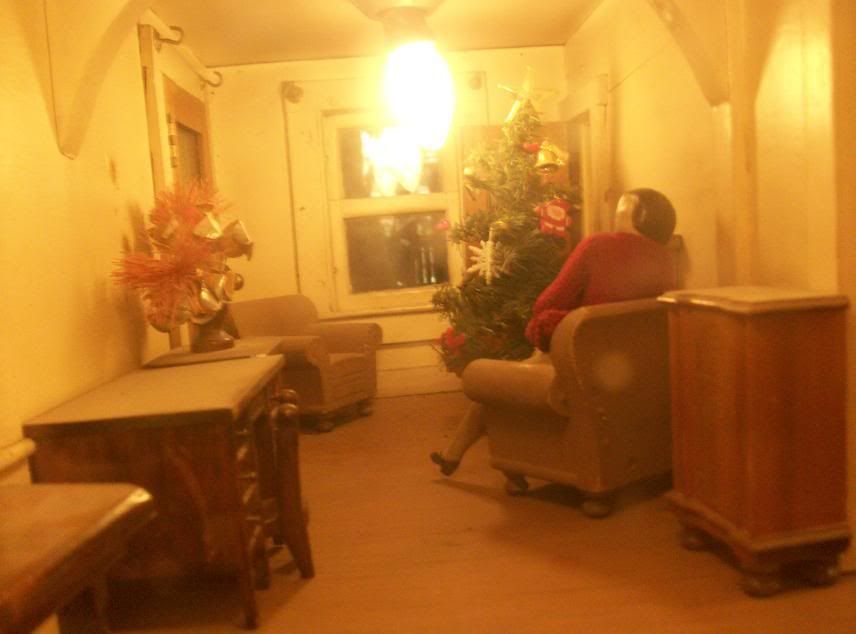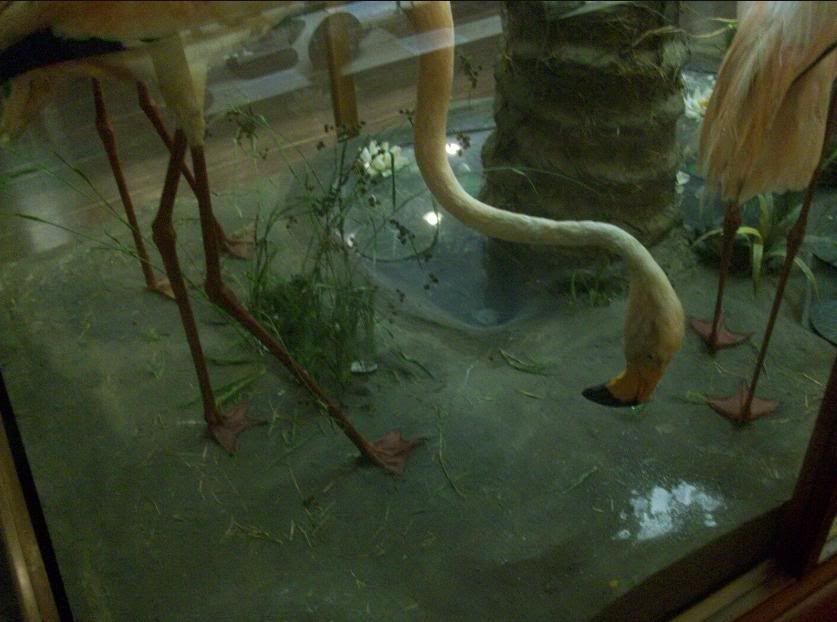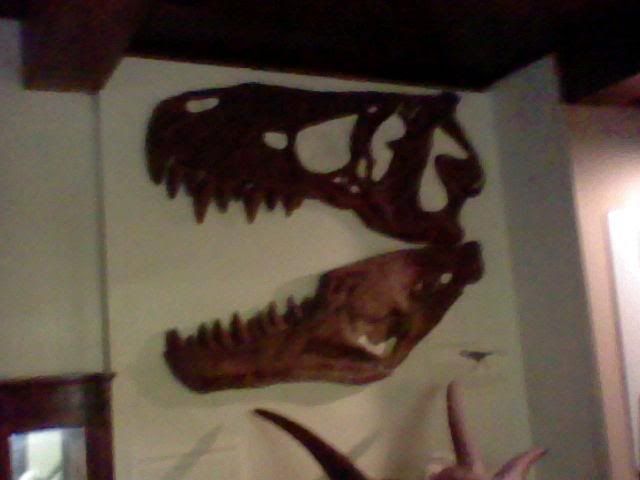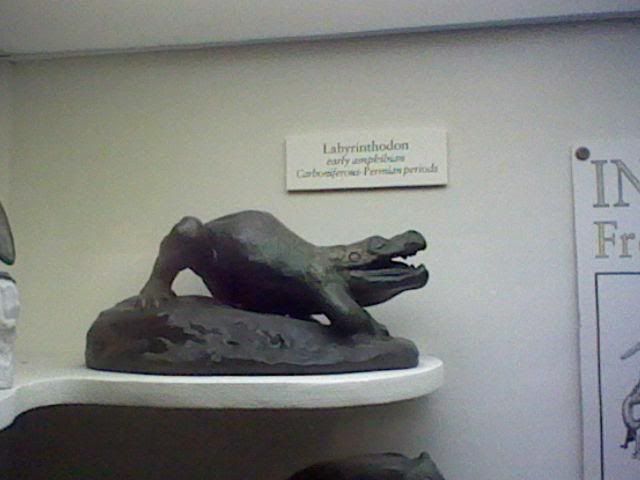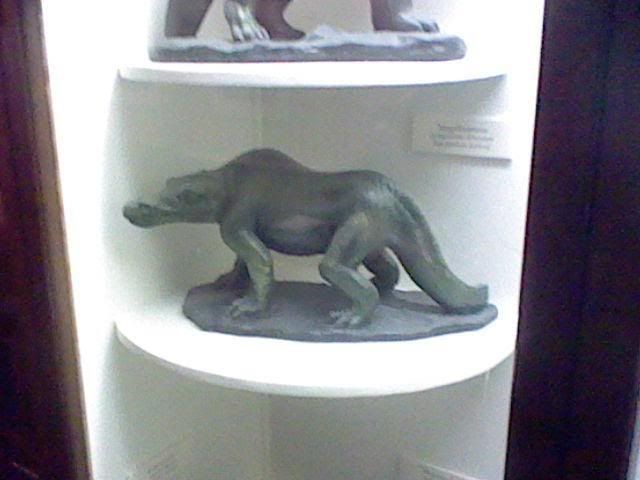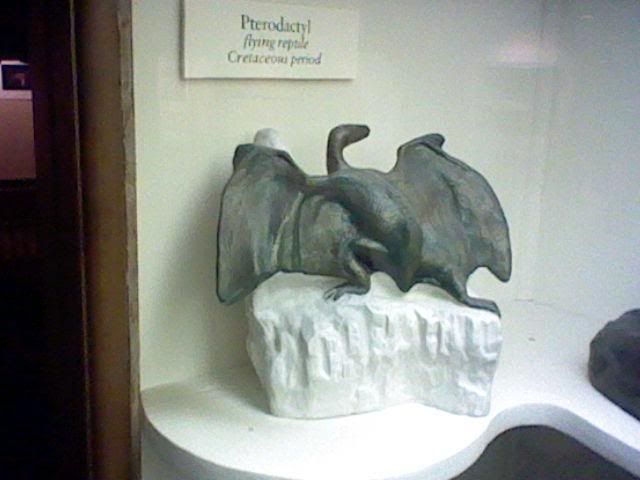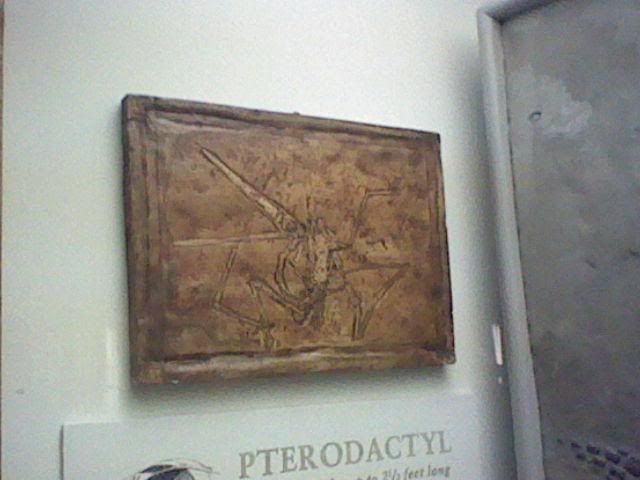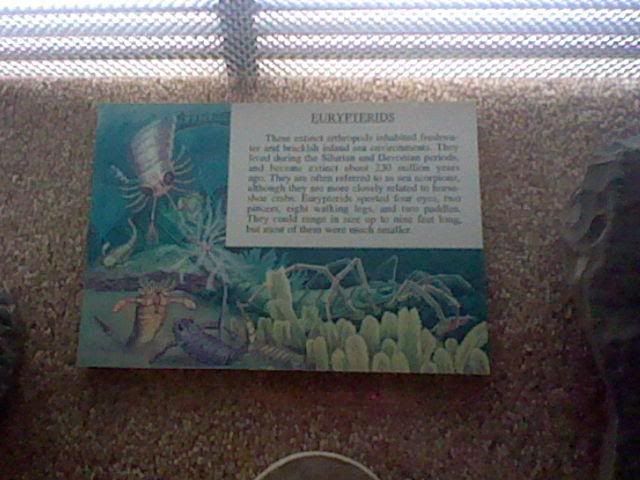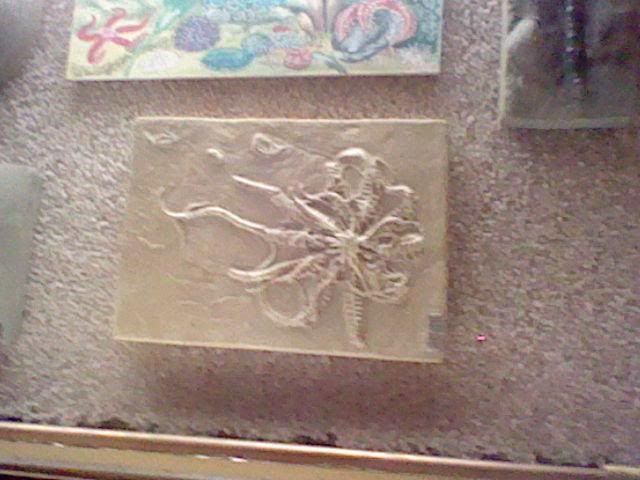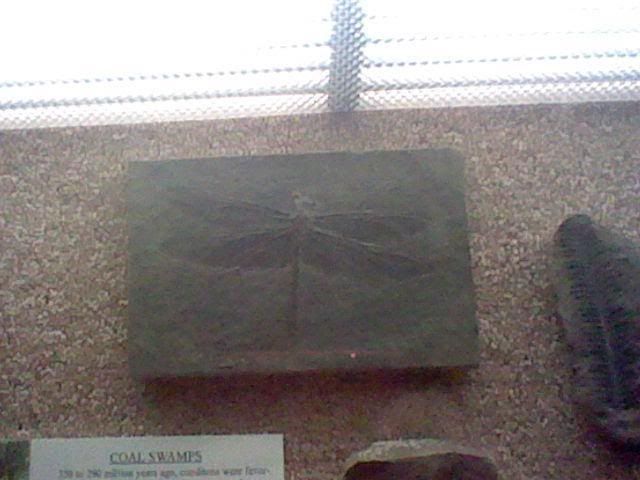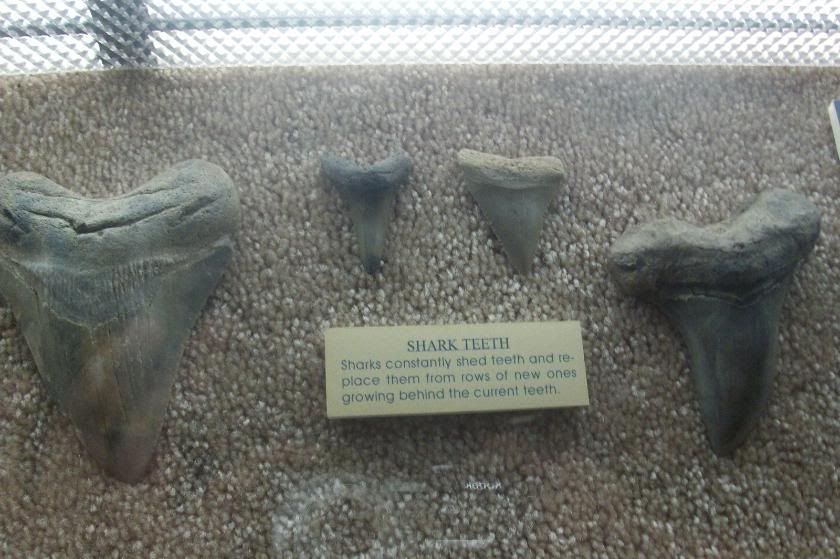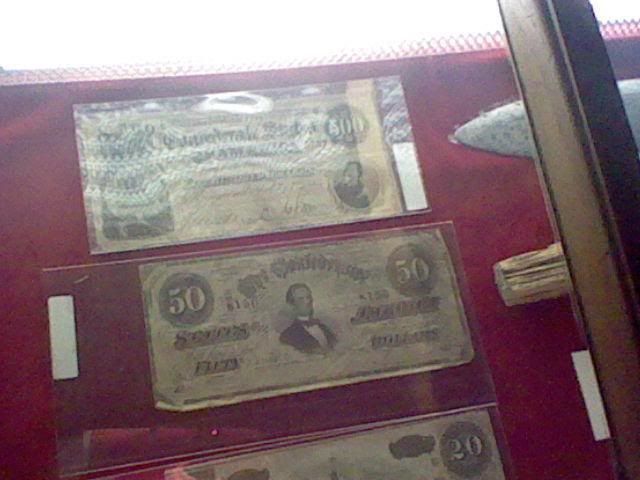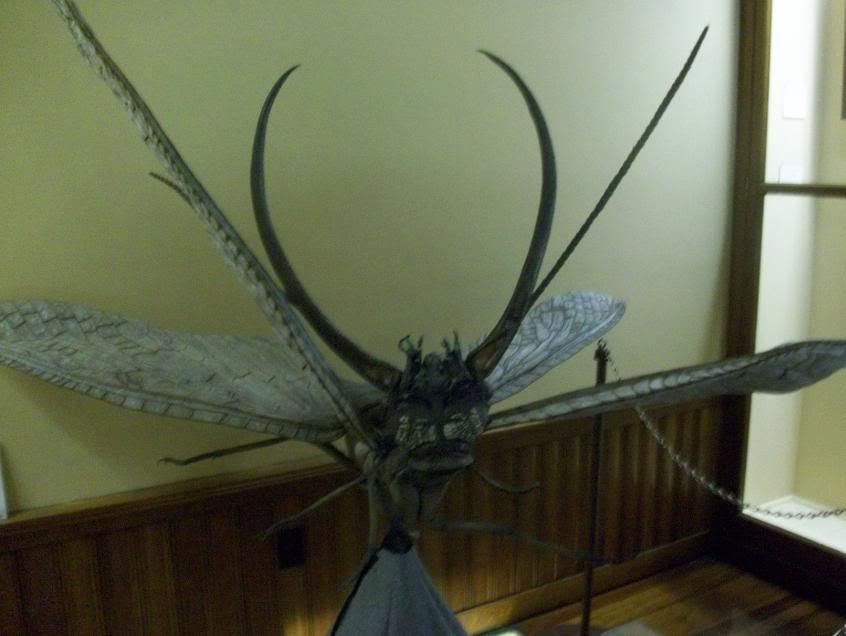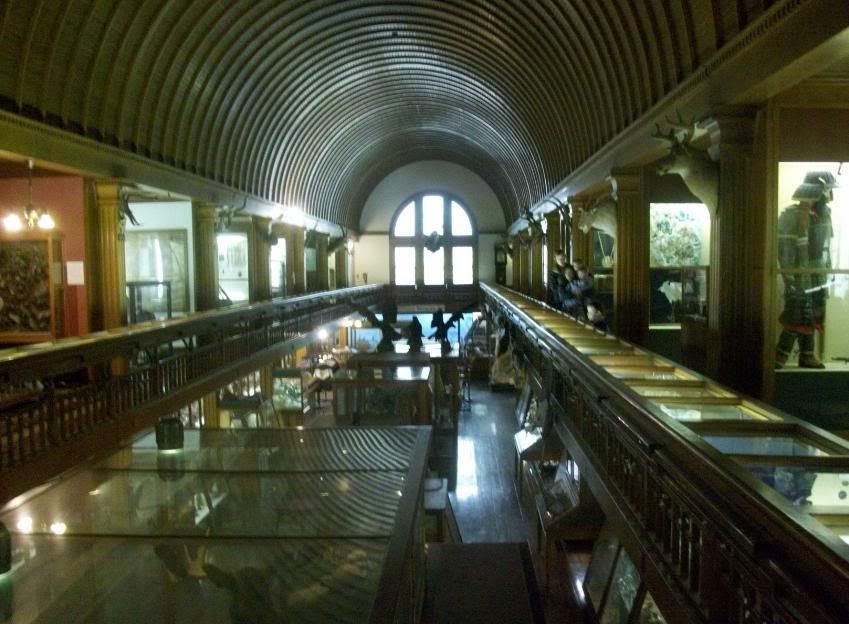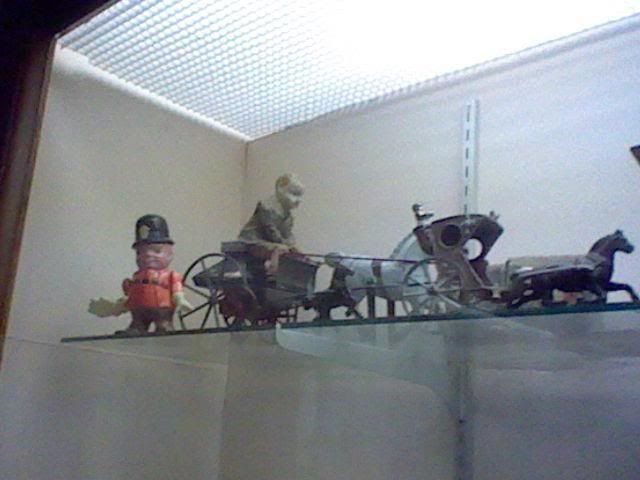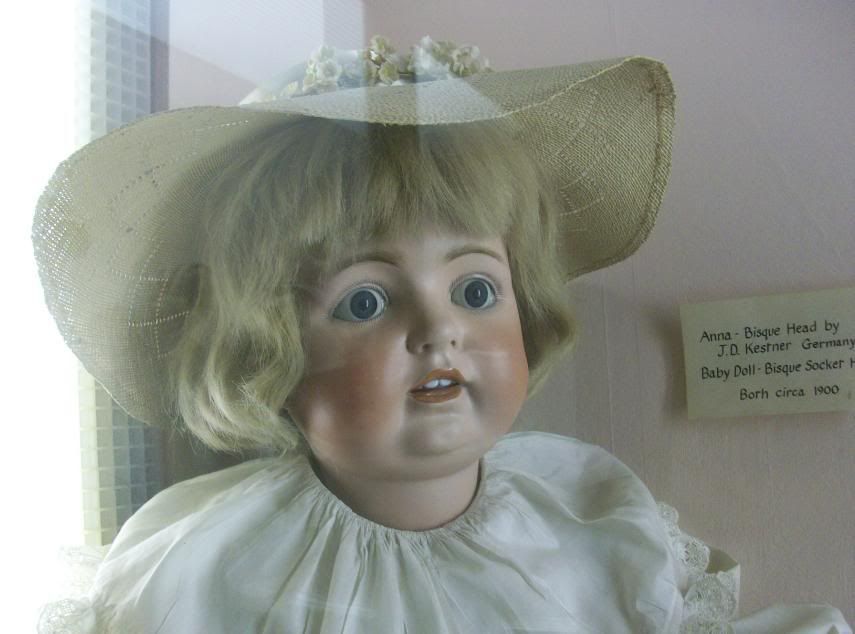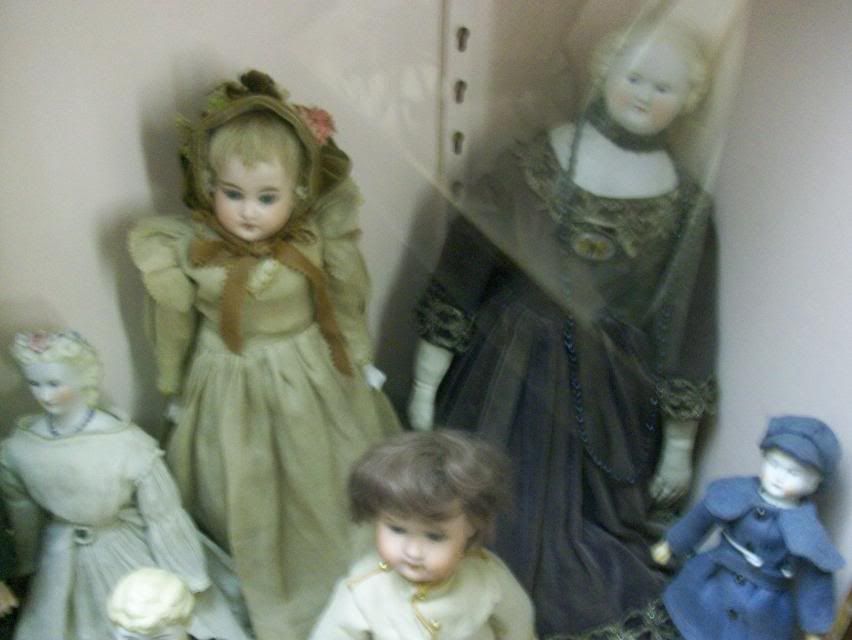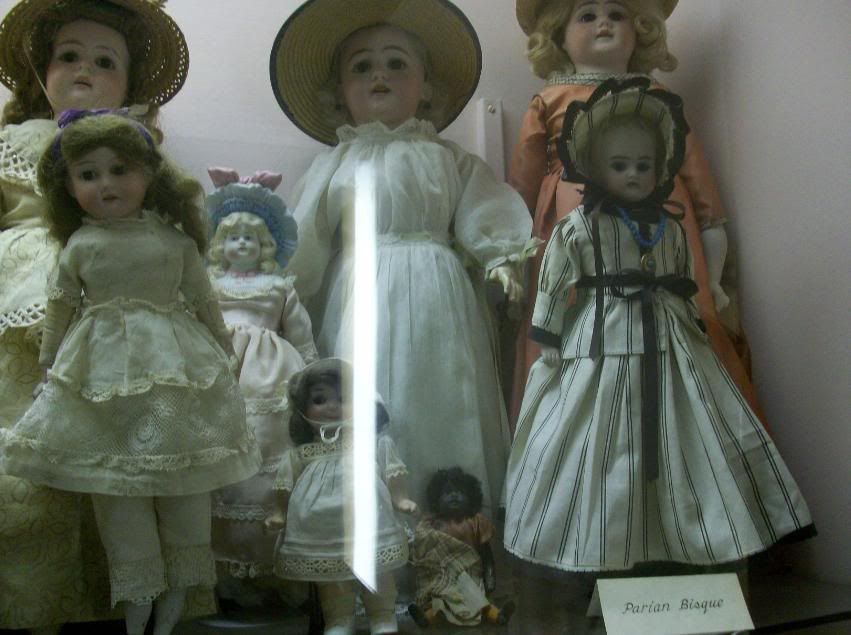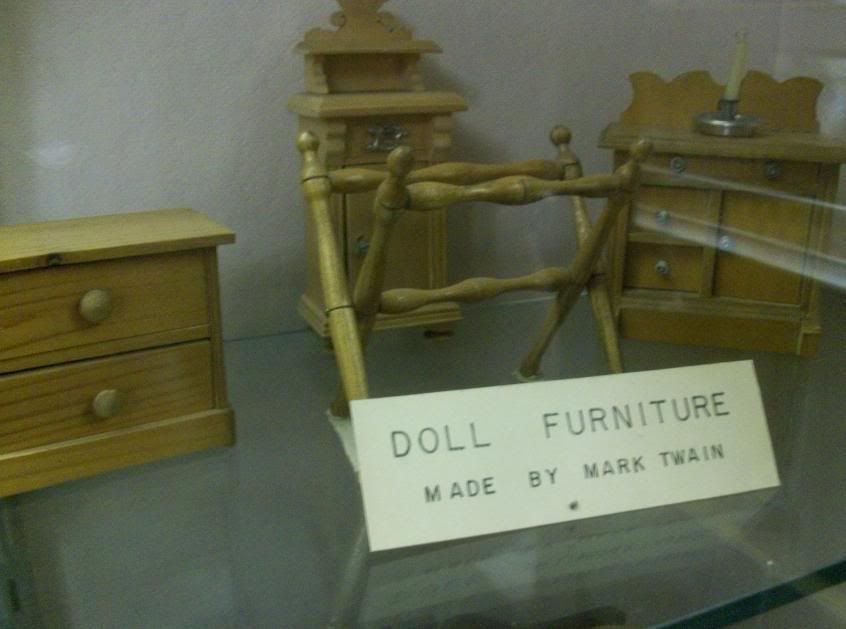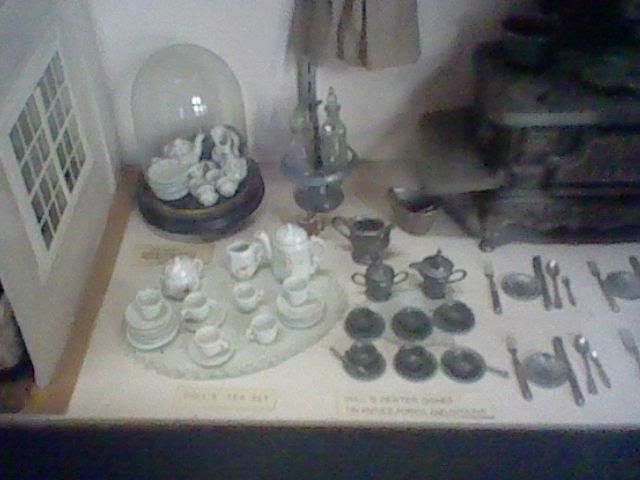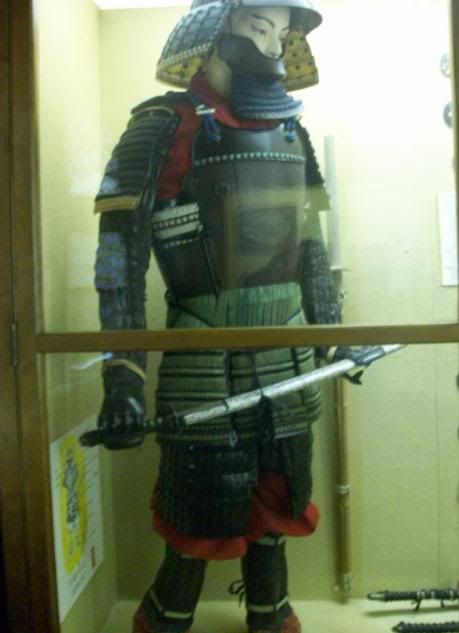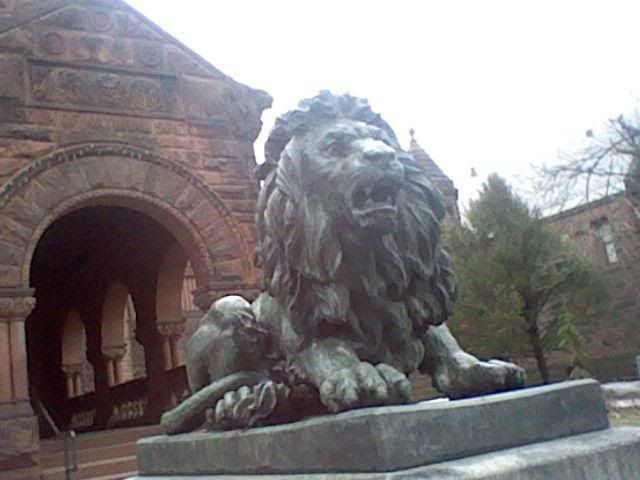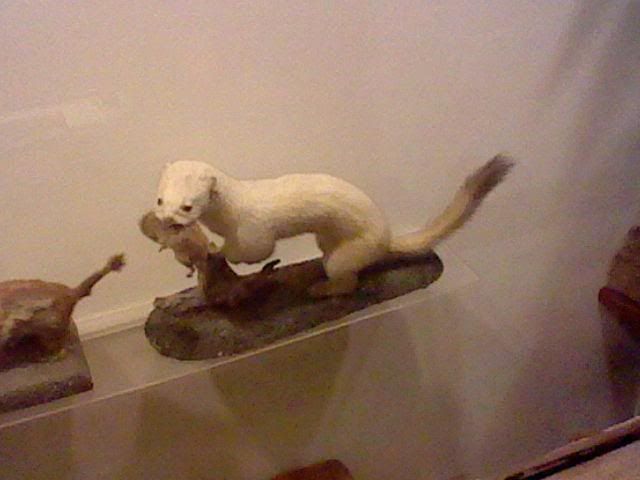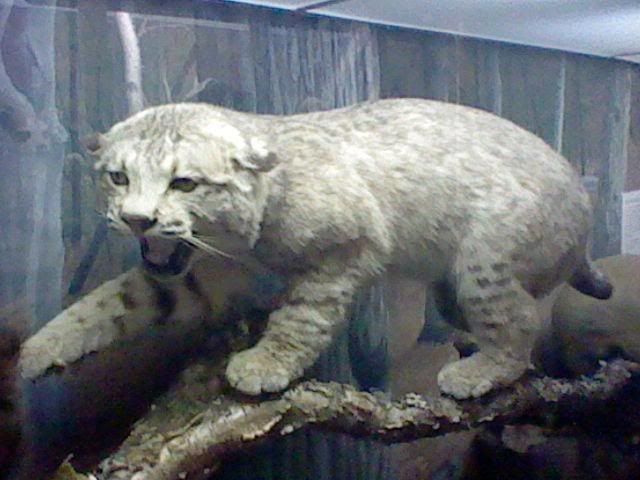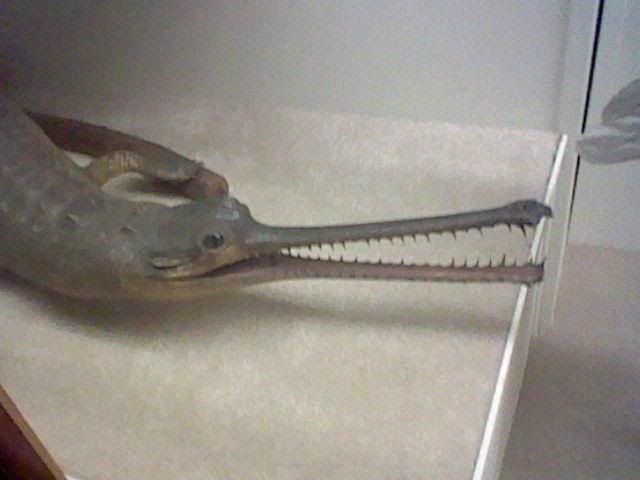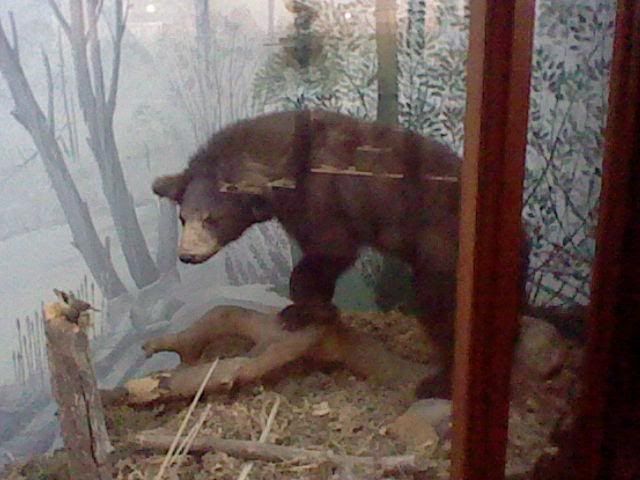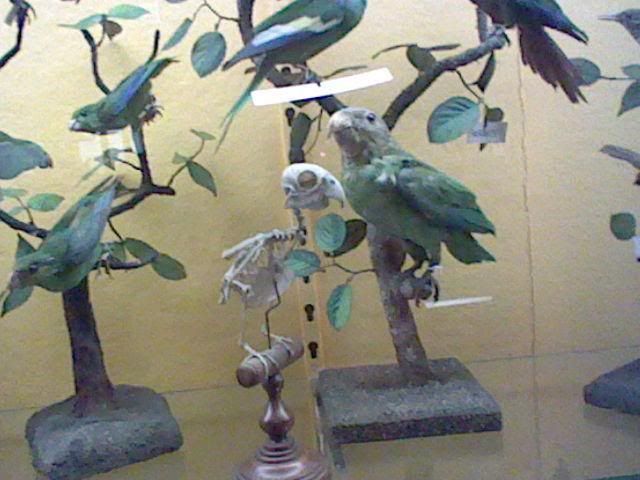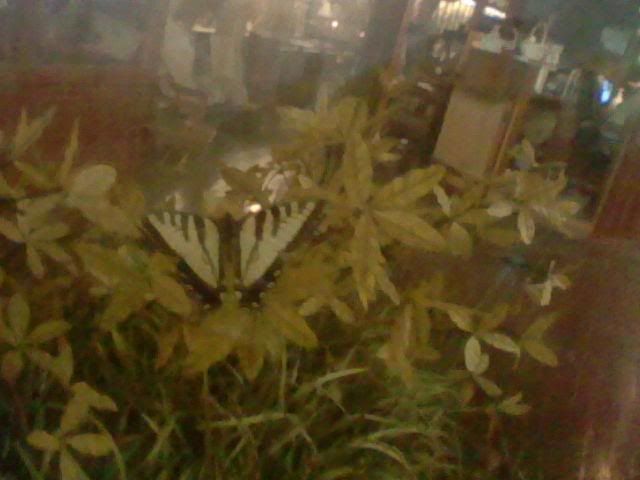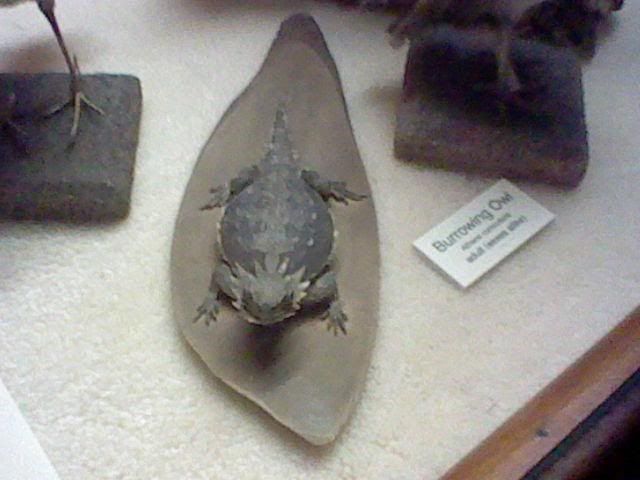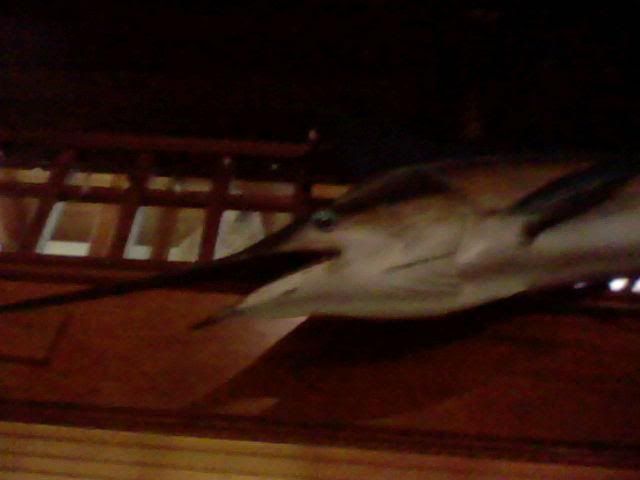Here's one last post about the Fairbanks Museum. My mom shot some photographs of exhibits I didn't, or my photos came out poorly, so we return to the first floor one more time.
Ah, the bears. The first things you see when you walk into the museum are the bears. They stand front and center, without any glass to separate you from them to make it even more up-close and personal. There is an alarm set to go off if you touch them, though, plus a bunch of signs that urge you to not touch the bears.
Kodiak and polar bears are the largest land carnivores on the planet, and other species of bear are no slouches either. They're all here, and have undoubtedly been at the forefront of many a family photo. I suspect they're amongst the most-photographed attractions in the museum.
The polar bear is one of the most famous and iconic animals, and is probably the first animal you think of when you think "Arctic". If you also think of "Antarctic", take note - polar bears only live at the North Pole, not the South Pole. Meanwhile, penguins only live at the South Pole. Therefore, if you see penguins and polar bears together in a cartoon or something, the creator either didn't do their homework or didn't care about being accurate when making cartoons (a perfectly reasonable attitude if you're not trying to teach the kids).
Speaking of penguins, look what else Mr. Fairbanks collected. This penguin wasn't labeled for whatever reason, and birds aren't my strongest area of animal knowledge so I don't know what species this is.
I idly wondered if perhaps the Fairbanks museum had any extinct animals on display. Perhaps it does - the sheer number of birds makes it downright likely one or two of the species has dwindled away in the last 120 years. However, the two I looked for were more famous examples - the dodo and the passenger pigeon - and I didn't find either. I later looked up dodos and discovered my error - the dodo went extinct in the 1600s, well over a hundred years before Mr. Fairbanks was even born, meaning he could never have gotten one for his collection.
The passenger pigeon, however, was still alive when the museum opened - it went extinct in the 1920s. I imagine if Fairbanks had such a bird, though, it would feature a good-sized plaque to tell the sad story of this species, and how humans somehow managed to make the most common bird in the world extinct.
Fairbanks does have one bird that almost went extinct - the California Condor, a bird that until recently was close to total extinction with only 22 left in the world. Since then, a breeding program has increased their numbers to just under 400.
While we're on the subject of birds, my mom shot this picture of some sort of vulture or condor that I managed to miss entirely thanks to not looking up.
...Actually, this might be a California Condor. I think I somehow managed to see the plaque and miss the animal. That or Fairbanks has two of them, because I'm pretty sure I saw some sort of vulture behind glass. Oh well.
The first floor is dominated by animal specimens, but it's not exclusively their domain: there are a couple of other things to see here. This music box is one example - built in the late 19th century, it was sort of like a record player, but with just one record that played a wide variety of songs depending on where the needle is placed.
Mom loved this dollhouse. It was designed after the builder's dream house. He worked from the inside out and crafted intricate rooms with furniture, decorations, and little people to populate it.
As if that wasn't cool enough, in this house it's always Christmas.
The Fairbanks Museum flamingos are white instead of pink. This is because flamingos get their color from the krill they eat. If fed something else, they will lose their pink color. It also fades after death, as these 120-year-old birds prove.
I've shared a lot of Fairbanks Museum in these four blog posts, but I still think it's worth your time to visit if you've never been. Not only is there plenty of stuff I didn't include, but actually visiting in person is a different experience from looking at pictures online. Plus, admission is reasonable.
By the way, Fairbanks Museum, like any attraction worth its salt, has a gift shop. There were a lot of comically overpriced things in there - one of the worst being little rubber bugs being sold for a dollar each when I can buy a bag of eight of those same bugs at the Dollar Tree for the same price - but I found something that wasn't too ridiculously marked up, was fitting to the museum, and was even practical. The thing I found was a 4-dollar pencil sharpener shaped like a potbelly stove, and although Fairbanks doesn't feature any stoves it's still evocative of the many antiques the second floor showcases. I took it home and immediately sharpened all my pencils. Definitely a good choice for souvenir.
Friday, March 23, 2012
Tuesday, March 20, 2012
The Fairbanks Museum - The Second Floor Continued
The front right corner of the Fairbanks Museum upper balcony features a small but nonetheless very cool selection of fossils.
The T Rex skull does a pretty good job of grabbing your attention, as does the Styracosaurus skull beneath it. Everybody knows T Rex. Styracosaurus is a bit more obscure, but to put it simply, this dinosaur was a close relative of the very famous Triceratops, just with more horns.
This was REALLY cool. Fairbanks had some statues of dinosaurs based on how people in the Victorian era thought they looked and acted. This 19th-century depiction of dinosaurs has been proven false by more recent discoveries, particularly from the seventies and onward, but the creatures imagined by the earliest dinosaur researchers are nonetheless fascinating. That pterodactyl fossil was pretty awesome, too. Also on display are a Dimetrodon foot, a fossil of a tiny dinosaur called Compsognathus, and several plaques discussing how people perceived dinosaurs over the years and, of course, the extinction of the group.
Here's a couple of plaques talking about animals that lived long before dinosaurs. The cephalopod family has a long history, and it still endures today in the form of the octopus, squid, nautilus, and cuttlefish. Sea scorpions, however, have been extinct for a very long time. Honestly, I'm kind of saddened by that, as I think sea scorpions are some of the most amazing-looking of all prehistoric animals. I wonder if one day an artificial robot sea scorpion will swim in a tank in a museum of the future to show people how they looked and behaved...
Two more fossils, one of which is a dragonfly a bit larger than most modern species. The other appears to be a starfish ancestor. I'm not certain which of the fossils at Fairbanks are genuine - the dinosaur skulls are stated on their plaques to be casts. One fossil on display that I didn't photograph was a trilobite shell. Trilobites, which looked a bit like horseshoe crabs, were not only very common in pre-dinosaur oceans, but they also shed their shells a lot, so there are lots of trilobite fossils. For that reason I'm pretty sure the trilobite fossil, at least, was the real thing and not a cast.
For the same reason, these shark teeth are definitely genuine. Sharks shed their teeth constantly, as the little plaque points out, so fossils are plentiful.
My mom liked the fossils, but she was definitely more intrigued by the Civil War section, which was next. Here we see some Confederate money, from the brief period of time when the confederacy was its own country.
The Civil War section was very well put together, showing a Confederate's weapons and equipment on one side and a United States soldier's stuff on the other side. Also on display were a couple of newspapers from around the same time period. Their advertisements were included for extra humor - five cents an issue! Dollar-fifty for a full year! Highway robbery, I do declare!
Among the last things we got a good look at on the second floor was this scaled-up model of a dobsonfly. As you might expect, I was intrigued and my mom was creeped out.
The dobsonfly is a very strange insect that can be found in Vermont, although I've never seen one. They are among the largest insects in New England, reaching up to five inches in length with ten-inch wingspans, and the males have giant pinching jaws, like the model. However, they have no poison and their jaws are actually so gigantic as to be hilariously unwieldy. They can't harm humans. The females, however, have much shorter jaws which they can use to great effect to draw blood from a human who mishandles them. If you see a female dobsonfly, show respect!
Dobsonflies only live a few weeks. They spend most of their lives (a few years) as hellgrammites, which look like what you'd get if you crossed a caterpillar with a stag beetle. These ferocious babies possess the same jaws the female adult does regardless of gender, so watch out! They live in freshwater, and if they are present it's a sign that the water is very clean and free of pollution, since hellgammites cannot survive in dirty water.
In my next and for now final post on the Fairbanks Museum, we'll take one last look downstairs at the preserved animals. There will be bears.
And dollhouses.
The T Rex skull does a pretty good job of grabbing your attention, as does the Styracosaurus skull beneath it. Everybody knows T Rex. Styracosaurus is a bit more obscure, but to put it simply, this dinosaur was a close relative of the very famous Triceratops, just with more horns.
This was REALLY cool. Fairbanks had some statues of dinosaurs based on how people in the Victorian era thought they looked and acted. This 19th-century depiction of dinosaurs has been proven false by more recent discoveries, particularly from the seventies and onward, but the creatures imagined by the earliest dinosaur researchers are nonetheless fascinating. That pterodactyl fossil was pretty awesome, too. Also on display are a Dimetrodon foot, a fossil of a tiny dinosaur called Compsognathus, and several plaques discussing how people perceived dinosaurs over the years and, of course, the extinction of the group.
Here's a couple of plaques talking about animals that lived long before dinosaurs. The cephalopod family has a long history, and it still endures today in the form of the octopus, squid, nautilus, and cuttlefish. Sea scorpions, however, have been extinct for a very long time. Honestly, I'm kind of saddened by that, as I think sea scorpions are some of the most amazing-looking of all prehistoric animals. I wonder if one day an artificial robot sea scorpion will swim in a tank in a museum of the future to show people how they looked and behaved...
Two more fossils, one of which is a dragonfly a bit larger than most modern species. The other appears to be a starfish ancestor. I'm not certain which of the fossils at Fairbanks are genuine - the dinosaur skulls are stated on their plaques to be casts. One fossil on display that I didn't photograph was a trilobite shell. Trilobites, which looked a bit like horseshoe crabs, were not only very common in pre-dinosaur oceans, but they also shed their shells a lot, so there are lots of trilobite fossils. For that reason I'm pretty sure the trilobite fossil, at least, was the real thing and not a cast.
For the same reason, these shark teeth are definitely genuine. Sharks shed their teeth constantly, as the little plaque points out, so fossils are plentiful.
My mom liked the fossils, but she was definitely more intrigued by the Civil War section, which was next. Here we see some Confederate money, from the brief period of time when the confederacy was its own country.
The Civil War section was very well put together, showing a Confederate's weapons and equipment on one side and a United States soldier's stuff on the other side. Also on display were a couple of newspapers from around the same time period. Their advertisements were included for extra humor - five cents an issue! Dollar-fifty for a full year! Highway robbery, I do declare!
Among the last things we got a good look at on the second floor was this scaled-up model of a dobsonfly. As you might expect, I was intrigued and my mom was creeped out.
The dobsonfly is a very strange insect that can be found in Vermont, although I've never seen one. They are among the largest insects in New England, reaching up to five inches in length with ten-inch wingspans, and the males have giant pinching jaws, like the model. However, they have no poison and their jaws are actually so gigantic as to be hilariously unwieldy. They can't harm humans. The females, however, have much shorter jaws which they can use to great effect to draw blood from a human who mishandles them. If you see a female dobsonfly, show respect!
Dobsonflies only live a few weeks. They spend most of their lives (a few years) as hellgrammites, which look like what you'd get if you crossed a caterpillar with a stag beetle. These ferocious babies possess the same jaws the female adult does regardless of gender, so watch out! They live in freshwater, and if they are present it's a sign that the water is very clean and free of pollution, since hellgammites cannot survive in dirty water.
In my next and for now final post on the Fairbanks Museum, we'll take one last look downstairs at the preserved animals. There will be bears.
And dollhouses.
Monday, March 19, 2012
The Fairbanks Museum - The Second Floor
The second floor of the Fairbanks Museum is a balcony overlooking the first floor. While the lower floor focuses on preserved animals, the upper floor concentrates mostly on things that were never alive, like artifacts from other cultures, weapons from the Civil War, Victorian-era children's toys, and a collection of rocks and minerals. There's still some mounted heads and horns here, though, as well as a small collection of fossils and other prehistoric treasures.
You may notice some of the photos in this post are bigger and higher-quality than the last post. This is because, while I was in control of my 3DS and its camera, my mother had our true digital camera with her and made good use of it. We'll be returning to the first floor later to see more of her photography. Between the two of us, we managed to capture a great cross-section of the museum.
We entered the second floor from the back left corner of the museum (that's based on the direction you face when you enter). The first exhibit you'll see from this area is a collection of antique toys children played with in the 19th century. Most of the toys were either vehicles or dolls and dollhouses, though there were also a few other types of playthings such as brain teasers and bouncing balls.
Mom took a big interest in the doll collection, snapping many pictures of it all.
Here's some doll furniture made by the one and only Mark Twain. Mom just about fainted with excitement. Few other things in the museum elicited such a response.
Also present were enough sets of plates and teacups to hold the most spectacular tea party of all time.
Another mom-pleaser was the section covering Japan. Mom has a big interest in Japanese culture and snapped a number of photos of the many little figurines on display.
The samurai outfit got almost as much of a reaction as Mark Twain's doll furniture.
After Japan, the exhibits move on to a collection of rocks and minerals as we round the corner and move back towards the front of the museum. We didn't take any pictures, partly because neither of us found rocks that interesting and partly because this part of the museum was very poorly lit. Fortunately, we were approaching my favorite part of the second floor: the fossils.
In my next post we'll cover the second half of the balcony. Fossils, dinosaurs, the Civil War and a dobsonfly await in the next installment.
Saturday, March 17, 2012
The Fairbanks Museum - The First Floor
The Fairbanks Museum is located in St. Johnsbury, Vermont, a ways from my home but a doable distance. I've visited Fairbanks at least three times in my life, and it hasn't changed much.
The museum is housed in a great old Victorian building, and was opened to the public in 1891. Joseph Fairbanks was the man responsible, who believed in educating the public about natural history. His extensive collection of curios has been preserved here for future generations. My mother and I visited Fairbanks on the 15th, and I brought my Nintendo 3DS along because it has a rudimentary camera function. Here's the first of two photo tours of the museum - and there's a lot I didn't photograph.
You'll start seeing interesting things before even entering the museum. There are two lion statues out front that lend a special air to the place. The building itself is just as fancy, with ornate carvings of humans and gargoyles. I tried to photograph the gargoyles but the shot came out poorly.
The majority of things to see on the first floor are preserved animals. Mr. Fairbanks worked together with one particular taxidermist to create the majority of his collection, and most of these specimens are therefore the same age or older than the museum, meaning they are at least 121 years old. Nobody who was alive when this eagle was alive is still with us today, and yet the eagle still looks as big as life, ready to fly out of its glass enclosure and into the sky. Just think about that.
Of course, taxidermy isn't perfect. Some of the animals in the museum looked a little odd, like the taxidermist had messed up a bit when creating them. This was most common with the mammals. I focused on photographing the better-looking specimens, but if you ever go there and take a good look at the bobcats, you'll see what i mean.
This animal goes by many names. You've heard of cougars? How about pumas? Mountain lions? Did you know all of those animals are actually the same thing? The mountain lion/cougar/puma is the biggest cat in the "small cats" division of the cat family.
The distinction between "big cats" and "small cats" isn't about size - that's a lucky coincidence. It's just how the cat family tree splits up. One group of cats - the lion, tiger, jaguar, and leopard - evolved large size and the ability to roar. All other cat species - wildcats, lynx, cougars, and the domestic cat, to name a few - cannot roar. There's a third group, too - the cheetah split off from other cats early on, and that's why it may look "un-catlike" in some ways. Cheetahs cannot roar.
The Fairbanks Museum contains mostly "small cats". This tiger is the only exception, and he is quite well preserved. Many of the standard "jungle animals" are not present at Fairbanks - there are no preserved lions, gorillas, hippos, rhinos, giraffes, etc. Most of the more exotic animals from other countries are quite small, making this tiger stand out.
Fairbanks is home to two stuffed crocodilians. The first is an alligator, large and impressive. The second is this decidedly more obscure creature, the gavial or gharial. It looks like a miniature crocodile, except for the extremely long and thin jaws. These jaws are specially designed to catch fish, and the needle-like teeth help keep a grip on them so they don't slip away.
Also contributing to the crocodile family's presence at Fairbanks is this alligator skull. When you first enter the museum, start by going to your left and checking out the glass tank that contains this skull alongside a peacock and a number of other animals - this is the best place to begin a museum tour thanks to the informative signs that introduce Mr. Fairbanks and quote him directly concerning his mission and the founding of the museum. There's even a letter he wrote himself on display.
Most people who've gone to Fairbanks Museum will instantly associate one thing with it: Bears. Even though birds are by far the most common animals at the museum, its the collection of six or so bears that catch people's attention. I was unable to get a good photo of the biggest and most impressive bears, but they've got all of the classics: a black bear, a grizzly bear, and a mighty polar bear. They're very imposing and undoubtedly among the most popular of the exhibits.
There are literally thousands of birds at Fairbanks. There are several hundred hummingbirds alone. Bird taxidermy was in fashion in Fairbanks' time, so he wound up with quite a collection of dead feathered friends. I am not a particularly huge bird fan so I didn't take too many bird pictures, but this parrot skeleton was too unique to pass up.
There are not very many insects at Fairbanks, to my disappointment. Most of them are "accessories" to larger displays. There is one really interesting insect exhibit - a giant model of a dobsonfly - on the second floor. For whatever reason I didn't photograph it. Aside from the dobsonfly, you'll only see a few insects here and there, like this butterfly which was nestled in a larger enclosure dedicated to mammals.
I think reptiles are good choices for taxidermy as they seem easy to "get right" without looking unnatural. This horned lizard is a good example - he looks pretty great for being 120 years old. It's not always a sure thing, though - a couple of the snakes in the snake tank looked odd. I took a snake photo but it came out very poorly so you won't be seeing it here.
On the outside of the railing between the first and second floor were a number of large fish. There was a shark, a sailfish, a tarpon, and this marlin. The marlin is known for being one of the fastest animals in the ocean, capable of reaching speeds of over 50 miles an hour. When it finds a school of fish, it attacks by waving its swordlike snout around, stunning or killing its prey.
That does it for the first floor. There were many animals I didn't photograph - everything from monkeys to a pelican, a pike, an albatross, a wolf, and a bison. Next post, we venture upstairs to see what else Fairbanks Museum can offer besides dead animals!
The museum is housed in a great old Victorian building, and was opened to the public in 1891. Joseph Fairbanks was the man responsible, who believed in educating the public about natural history. His extensive collection of curios has been preserved here for future generations. My mother and I visited Fairbanks on the 15th, and I brought my Nintendo 3DS along because it has a rudimentary camera function. Here's the first of two photo tours of the museum - and there's a lot I didn't photograph.
You'll start seeing interesting things before even entering the museum. There are two lion statues out front that lend a special air to the place. The building itself is just as fancy, with ornate carvings of humans and gargoyles. I tried to photograph the gargoyles but the shot came out poorly.
The majority of things to see on the first floor are preserved animals. Mr. Fairbanks worked together with one particular taxidermist to create the majority of his collection, and most of these specimens are therefore the same age or older than the museum, meaning they are at least 121 years old. Nobody who was alive when this eagle was alive is still with us today, and yet the eagle still looks as big as life, ready to fly out of its glass enclosure and into the sky. Just think about that.
Of course, taxidermy isn't perfect. Some of the animals in the museum looked a little odd, like the taxidermist had messed up a bit when creating them. This was most common with the mammals. I focused on photographing the better-looking specimens, but if you ever go there and take a good look at the bobcats, you'll see what i mean.
This animal goes by many names. You've heard of cougars? How about pumas? Mountain lions? Did you know all of those animals are actually the same thing? The mountain lion/cougar/puma is the biggest cat in the "small cats" division of the cat family.
The distinction between "big cats" and "small cats" isn't about size - that's a lucky coincidence. It's just how the cat family tree splits up. One group of cats - the lion, tiger, jaguar, and leopard - evolved large size and the ability to roar. All other cat species - wildcats, lynx, cougars, and the domestic cat, to name a few - cannot roar. There's a third group, too - the cheetah split off from other cats early on, and that's why it may look "un-catlike" in some ways. Cheetahs cannot roar.
The Fairbanks Museum contains mostly "small cats". This tiger is the only exception, and he is quite well preserved. Many of the standard "jungle animals" are not present at Fairbanks - there are no preserved lions, gorillas, hippos, rhinos, giraffes, etc. Most of the more exotic animals from other countries are quite small, making this tiger stand out.
Fairbanks is home to two stuffed crocodilians. The first is an alligator, large and impressive. The second is this decidedly more obscure creature, the gavial or gharial. It looks like a miniature crocodile, except for the extremely long and thin jaws. These jaws are specially designed to catch fish, and the needle-like teeth help keep a grip on them so they don't slip away.
Also contributing to the crocodile family's presence at Fairbanks is this alligator skull. When you first enter the museum, start by going to your left and checking out the glass tank that contains this skull alongside a peacock and a number of other animals - this is the best place to begin a museum tour thanks to the informative signs that introduce Mr. Fairbanks and quote him directly concerning his mission and the founding of the museum. There's even a letter he wrote himself on display.
Most people who've gone to Fairbanks Museum will instantly associate one thing with it: Bears. Even though birds are by far the most common animals at the museum, its the collection of six or so bears that catch people's attention. I was unable to get a good photo of the biggest and most impressive bears, but they've got all of the classics: a black bear, a grizzly bear, and a mighty polar bear. They're very imposing and undoubtedly among the most popular of the exhibits.
There are literally thousands of birds at Fairbanks. There are several hundred hummingbirds alone. Bird taxidermy was in fashion in Fairbanks' time, so he wound up with quite a collection of dead feathered friends. I am not a particularly huge bird fan so I didn't take too many bird pictures, but this parrot skeleton was too unique to pass up.
There are not very many insects at Fairbanks, to my disappointment. Most of them are "accessories" to larger displays. There is one really interesting insect exhibit - a giant model of a dobsonfly - on the second floor. For whatever reason I didn't photograph it. Aside from the dobsonfly, you'll only see a few insects here and there, like this butterfly which was nestled in a larger enclosure dedicated to mammals.
I think reptiles are good choices for taxidermy as they seem easy to "get right" without looking unnatural. This horned lizard is a good example - he looks pretty great for being 120 years old. It's not always a sure thing, though - a couple of the snakes in the snake tank looked odd. I took a snake photo but it came out very poorly so you won't be seeing it here.
On the outside of the railing between the first and second floor were a number of large fish. There was a shark, a sailfish, a tarpon, and this marlin. The marlin is known for being one of the fastest animals in the ocean, capable of reaching speeds of over 50 miles an hour. When it finds a school of fish, it attacks by waving its swordlike snout around, stunning or killing its prey.
That does it for the first floor. There were many animals I didn't photograph - everything from monkeys to a pelican, a pike, an albatross, a wolf, and a bison. Next post, we venture upstairs to see what else Fairbanks Museum can offer besides dead animals!
Wednesday, March 7, 2012
The Death of the Traditional Book
Last week, my mom got a Kindle. Although it took her a few days to start using it (she says new technology intimidates her at first) she is now extremely into it and has been reading up a storm. I've been thinking lately about traditional paper books, and whether they have a place in the future. I'm going to just weigh out some pros and cons here between paper books and electronic books.
Storage Space
No doubt about it, this is one of the biggest reasons to get a Kindle or some other e-reader. If you're limited in terms of storage, a single tiny machine a little bigger than a novel but much thinner is much more attractive than shelves of books. It's also the way to go for portability. My inner collector still loves having lots of books, though.
Cost
A lot of ebooks are being sold for almost as much as - or even more than - physical copies. This is greed. An ebook requires no publishing, no shipping or handling, no warehouses to be stocked in. It's a digital file, and has far, far less overhead for the company. They should be significantly less expensive.
Other ebooks are cheap or free. Free is always a good price. You can get paper books free (or incredibly cheap) as well by visiting libraries, yard sales, and the like.
There is also, of course, the cost of the reader itself. A Kindle can be bought fairly cheaply (Amazon makes their money on ebooks, not readers) but it's still a pretty decent investment to make before you can start reading. Something to keep in mind.
Visibility
This is something most people my age don't think about. My mom loves to read, but she has difficulty with small type. The Kindle came to the rescue with an adjustable font size, allowing my mom to read clearly once more. It made her very happy to be able to read again, and it's something I thank the Kindle for. It's also something paper books utterly fail at, because A) not every book has a Large Print edition and B) you can't make your existing books into Large Print books with the press of a button.
Book Selection
The number of books that only exist as ebooks is growing and will continue to grow. Think back to the early 2000s, and how movies were released on both DVD and VHS for a while, but more and more movies were DVD only over time. However, at the same time, there are movies that came out on VHS in the eighties and nineties but were never rereleased on DVD when the new technology came. I think this will be the case with books - there will never be an electronic version of every paper book ever made, therefore paper books are not completely irrelevant and may be very useful in certain situations.
The Cloud
For those who don't know, "The Cloud" is shorthand for storing things on the Internet instead of on your own computer or owning a physical object.
This is something I've been hung up on for a while. Something I think is very important - if I pay for something, I want to own it. I don't want the company to be able to edit or remove it. I don't want to be charged a fee for continuing to own something. I want to be in control, not the company and their cloud. After they sell something to me, I should have the right to do as I wish - to lend it out, to read it over and over, to resell it.
For the same reason, I've been wary of the recent popularity of digital game downloads (although I've bought a few I couldn't get any other way). Services like Microsoft's Xbox Live Arcade and Nintendo's Virtual Console are neat and all, but should something happen to my video game system, the games stored on it are gone. I want to have a physical object, like a cartridge or disc. It is much more reassuring and solidly mine. I also hate that digital books and games can't be resold. I can't go to a garage sale and buy a used ebook. This movement towards digital and intangible things can crush the resale market, a market I have frequently relied on for both books and games as a way to buy things cheaply.
Conclusion
I've said before that I generally embrace new technology. This is true. I think ebooks have great potential. But I want to be the sole owner of things that I pay for, and so I personally believe that paper books will remain relevant to me as long as I live, even if they don't to anyone else.
That said, I may browse my mother's Kindle and see if there's any free nonfiction books about animals...
Storage Space
No doubt about it, this is one of the biggest reasons to get a Kindle or some other e-reader. If you're limited in terms of storage, a single tiny machine a little bigger than a novel but much thinner is much more attractive than shelves of books. It's also the way to go for portability. My inner collector still loves having lots of books, though.
Cost
A lot of ebooks are being sold for almost as much as - or even more than - physical copies. This is greed. An ebook requires no publishing, no shipping or handling, no warehouses to be stocked in. It's a digital file, and has far, far less overhead for the company. They should be significantly less expensive.
Other ebooks are cheap or free. Free is always a good price. You can get paper books free (or incredibly cheap) as well by visiting libraries, yard sales, and the like.
There is also, of course, the cost of the reader itself. A Kindle can be bought fairly cheaply (Amazon makes their money on ebooks, not readers) but it's still a pretty decent investment to make before you can start reading. Something to keep in mind.
Visibility
This is something most people my age don't think about. My mom loves to read, but she has difficulty with small type. The Kindle came to the rescue with an adjustable font size, allowing my mom to read clearly once more. It made her very happy to be able to read again, and it's something I thank the Kindle for. It's also something paper books utterly fail at, because A) not every book has a Large Print edition and B) you can't make your existing books into Large Print books with the press of a button.
Book Selection
The number of books that only exist as ebooks is growing and will continue to grow. Think back to the early 2000s, and how movies were released on both DVD and VHS for a while, but more and more movies were DVD only over time. However, at the same time, there are movies that came out on VHS in the eighties and nineties but were never rereleased on DVD when the new technology came. I think this will be the case with books - there will never be an electronic version of every paper book ever made, therefore paper books are not completely irrelevant and may be very useful in certain situations.
The Cloud
For those who don't know, "The Cloud" is shorthand for storing things on the Internet instead of on your own computer or owning a physical object.
This is something I've been hung up on for a while. Something I think is very important - if I pay for something, I want to own it. I don't want the company to be able to edit or remove it. I don't want to be charged a fee for continuing to own something. I want to be in control, not the company and their cloud. After they sell something to me, I should have the right to do as I wish - to lend it out, to read it over and over, to resell it.
For the same reason, I've been wary of the recent popularity of digital game downloads (although I've bought a few I couldn't get any other way). Services like Microsoft's Xbox Live Arcade and Nintendo's Virtual Console are neat and all, but should something happen to my video game system, the games stored on it are gone. I want to have a physical object, like a cartridge or disc. It is much more reassuring and solidly mine. I also hate that digital books and games can't be resold. I can't go to a garage sale and buy a used ebook. This movement towards digital and intangible things can crush the resale market, a market I have frequently relied on for both books and games as a way to buy things cheaply.
Conclusion
I've said before that I generally embrace new technology. This is true. I think ebooks have great potential. But I want to be the sole owner of things that I pay for, and so I personally believe that paper books will remain relevant to me as long as I live, even if they don't to anyone else.
That said, I may browse my mother's Kindle and see if there's any free nonfiction books about animals...
Subscribe to:
Comments (Atom)
